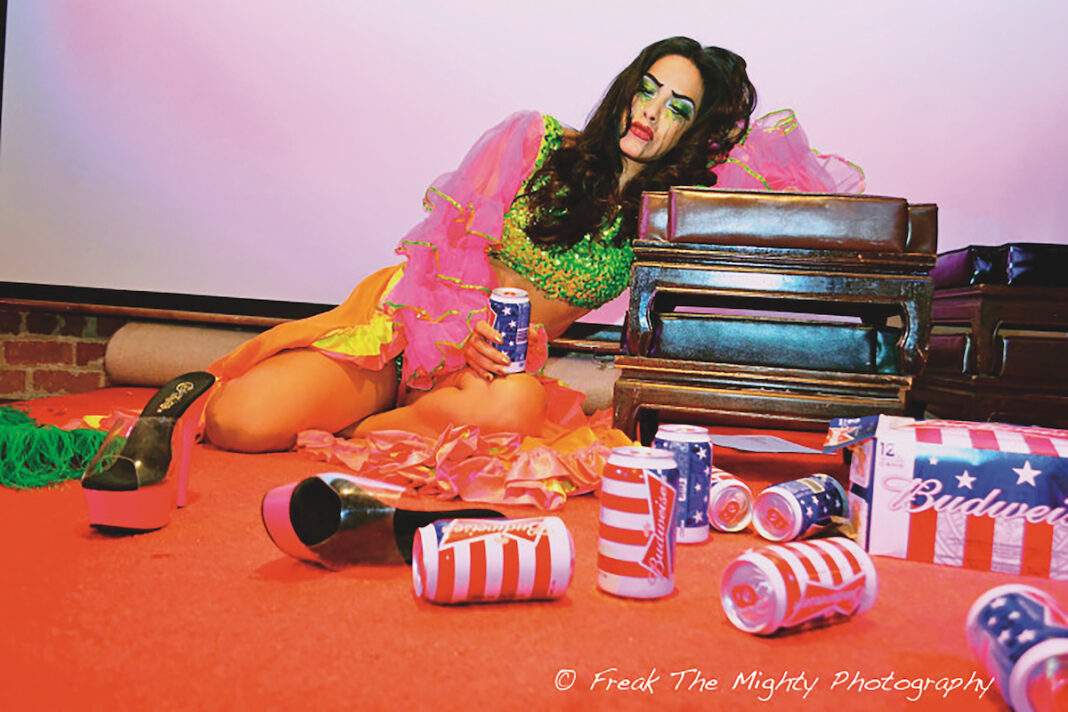“Do you identify as a feminist?”
If the answer is, “Yes,” you might be lauded or vilified. To some, you are a courageous activist fighting for equal rights and justice for half of the world’s population. To others, you are a culture-destroying denier of the natural order of things.
But even within the self-identifying group, the last couple of decades have seen debate and reexamination. Have the waves of feminism primarily benefitted white, mostly middle-class and above, cisgender women? How can more voices and more situations be included, both now, and in looking at feminist history?
These questions have provoked political discussion, and also sparked artists and curators to respond. The 100th anniversary in 2020 of the 19th Amendment, granting American women the right to vote, inspired many institutions to plan exhibits—only to have the pandemic force postponements.
The Berkeley Art Museum and Pacific Film Archive’s now-closed “New Time: Art and Feminisms in the 21st Century,” was one of these. Now comes the also-delayed “Hella Feminist” exhibition at the Oakland Museum of California (OMCA), which opened this summer and runs through Jan. 8, 2023.
Co-curated by OMCA’s Carin Adams and independent curator Erendina Delgadillo, with Lisa Silberstein, “Hella Feminist” showcases both art and historical artifacts that “explore the diverse individual and collective stories of feminism,” according to museum materials. It focuses, as is OMCA’s mission, on work and stories from the Bay Area and California, centered on the last 100 years.
Included are historic objects from the OMCA collection, such as posters, pins and photographs, alongside contemporary work commissioned for the exhibition. The impact reflects the concept that “all elements of identity are interlinked,” and that none can be addressed in isolation.
Adams’ and Delgadillo’s answers to “Do you identify as feminist?” help to illustrate the wide range of introductions and responses to feminism.
“I grew up with a mother who did not identify as a feminist,” Adams said. “As a young woman, I was ambivalent about feminism. I felt distanced from it. It was a complicated journey. But, yes, I consider myself a feminist.”
“Yes, definitely,” said Delgadillo. “I am a Millennial. I was raised by a mother who was political, as was her family. I had a interesting relationship with feminism…I rebelled in my teen years.”
Their experiences, as well as those of exhibit contributor Silberstein, helped them create the theme for an exhibition that aims to “challenge, provoke and inspire visitors to reconsider and expand their understanding of feminism and its complicated history.” Delgadillo explained, “‘Hella Feminist’ [highlights] the lesser-known elements of feminist histories—particularly the experiences of people of color—but also demonstrate[s] how mainstream feminism at times made harmful compromises that were exclusionary.”
Take, for example, the passage of the 19th Amendment. The language of the amendment does not mention race: “The right of citizens of the United States to vote shall not be denied or abridged by the United States or by any State on account of sex.”
Yet the consequences of its passage enfranchised primarily white women, and the early suffrage movement experienced a wrenching schism when some of the most prominent white suffragettes, including Susan B. Anthony and Elizabeth Cady Stanton, opposed the passage of the 15th Amendment, granting Black men the right to vote. Black suffragist Frances Ellen Watkins Harper wrote of her feeling of betrayal: “When it was a question of race, I let the lesser question of sex go. But the white women all go for sex, letting race occupy a minor position.”
Mind, Body and Spirit
The process of deciding what to include in “Hella Feminist” was not “strictly linear,” said Adams. The curators looked at what stories could not be represented by items in the collection, and engaged in extended conversations with contemporary artists.
Some inspiration has come from personal experiences. Visitors enter the exhibition through a long hallway filled with a variety of undergarments from the museum’s extensive collection, many of which have never been displayed to the public before.
Adams had earlier been curating a survey of textiles, and while looking through the OMCA collection, found it “really strange and illuminating” to view the undergarments of women from a century ago through the early 1980s, including a corset intended for use by a nursing mother. This reminded her of seeing items in her own mother’s closet, girdles and corsets that would have been standard wear for women born in the 1930s. So the exhibit’s entry includes corsets, stockings, petticoats and underwear from the mid-19th century to the present day. Interspersed among the garments are dress forms, mannequins and leg molds, “inviting the viewer to confront idealized female bodies of the past.”
The “Mind” section of “Hella Feminist” is designed to “set the social and political contexts (laws, social expectations, policy, popular culture) that feminism addresses.” It features a site-specific installation by Kate Schatz and Miriam Klein Stahl, creators of bestselling books Rad Women Worldwide and Rad Girls Can, using 300 papercut portraits of women and nonbinary people from Oakland, Berkeley and the East Bay. Each portrait is numbered, and a corresponding zine produced especially for the exhibition tells viewers about who each person is and what kind of work they do.The installation also includes audio interviews with those featured.
Kate Schatz’s collaboration with W. Kamau Bell, Do the Work: An Anti-Racist Activity Book, was released right before “Hella Feminist” opened. Bay Area artist, educator and activist Miriam Klein Stahl is also the co-founder of the Arts and Humanities Academy at Berkeley High School, where she has taught since 1995.
Another part of “Mind” is a section on what the curators call the “four waves of feminism.” Acknowledging that there is not complete academic consensus about exact dates, Delgadillo said these “waves” represent 1840-1920, 1963-mid-1980s, 1992-early 2000s and 2000-present. These exhibits “provide a series of victories and challenges that feminists have faced,” said Delgadillo.
The “Body” section engages visitors in the ways in which female/femme bodies have been “judged, restricted, regulated and celebrated.” Here, historic posters from abortion rights rallies, birth control handbooks, exhibits showing the evolution of sex education in the Bay Area and diverse sex toys from Feelmore Oakland are displayed.
“We can’t define feminism,” said Delgadillo. “But the posters help illuminate what concrete moments were like, what the passion looked like.” At least one is from the famous Hookers’ Ball, which raised money for Margo St. James’ sex workers’ organization C.O.Y.O.T.E. (“Call Off Your Tired Old Ethics”) from 1974-1979. Others highlight the resistance to forced sterilization.
Also featured is contemporary work by Oakland-based interdisciplinary artist Xandra Ibarra. Sometimes creating under the alias of La Chica Boom, Ibarra uses performance, video and sculpture to “address abjection and joy and the borders between proper and improper racialized, gendered and queer subjects.”
“Hella Feminist” includes Ibarra’s She’s on the Rag, a print series made from menstrual blood, as well as documentation from Ibarra’s performances as La Chica Boom, a “hyper-sexualized, hyper-racialized” version of herself.
Another part of “Body” is an interactive display by Bay Area astrologer and medium Jessica Lanyadoo, host of the top-ranking astrology and advice show, Ghost of a Podcast, and the co-founder of the get-out-the-vote project, “Zodiac the Vote.” In this area, exhibit visitors can “release their frustrations, anger, despair, exhaustion and other emotions caused by a world that continues to be inequitable and unjust,” according to museum materials.
“Spirit” contains “some of the most exciting artwork in the exhibit,” said Adams. Much is interactive, and created to help underline that there is “an emotional aspect to what it means to be a feminist,” said Delgadillo. The movement of the ’60s and ’70s celebrating “witch power” is featured, along with contemporary women of color’s search to “reconnect with spiritual practices that have been lost,” she said.
An Evolving Exhibit
The sections of “Hella Feminist” continued to evolve before the July opening, said Adams. “It’s a mixture of research and reaching out to the artists. Much of the art hasn’t been created yet,” she explained at the time. Both Adams and Delgadillo expressed their excitement about an installation contributed by the East Bay’s The Church of Black Feminist Thought, a spiritual-political education project co-convened by Ra Malika Imhotep and Miyuki Baker.
The project’s goals include “[surfacing] all the hidden labor done by Black feminist artists, scholars and writers.” Since January 2018, project members have been meeting in Berkeley, Oakland and over Zoom with an intergenerational group of artists, discussing the work of Octavia Butler, Hortense Spillers, Saidiya Hartman, Toni Morrison, Nina Simone, Ula Y. Taylor, Ntozake Shange, local artist Amara T. Smith, The Beautiful Being Project (Europa Grace and Arisa White), Audre Lorde, bell hooks, Patricia Hill Collins, Alexis Pauline Gumbs and others.
“We are most excited about this project because it lives at the intersection of gender, race, critical theory and visual art,” the founders note on their website.
Said Delgadillo before the exhibit opened, “The Church of Black Feminist Thought has been developing ‘invocations’ to introduce their work…it’s both an academic and spiritual practice.”
The group’s exhibit includes a dress worn by an escaped slave, along with other objects. They also chose an object from the OMCA collection for each of the four waves. “They are pushing at the ‘squareness’ [of traditional museum exhibit formats],” said Delgadillo.
Adams described the overall project this way: “By looking back at history while inviting contemporary artists to comment on the present, ‘Hella Feminist’ invites visitors to consider a future where feminism looks beyond gender-based inequality to the intersection of multiple aspects of identity.”
‘Hella Feminist’ is up through Jan. 8, 2023. Oakland Museum of California, 1000 Oak St., Oakland. 510-318-8400, museumca.org











